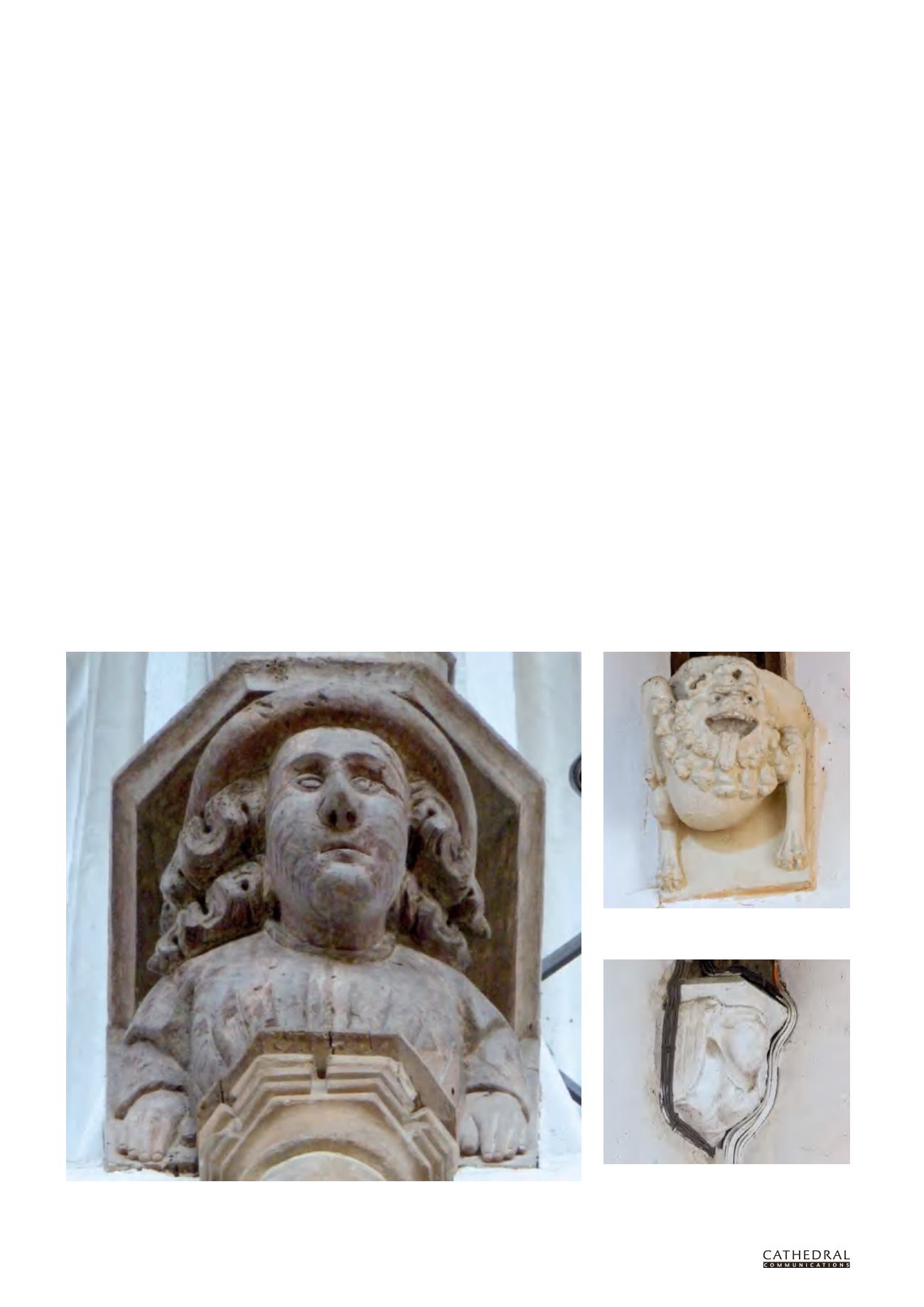

18
BCD SPECIAL REPORT ON
HISTORIC CHURCHES
22
ND ANNUAL EDITION
Portrait bust of a patron at St Peter Mancroft, Norwich
A heavily limewashed angel corbel surrounded by
electrical cabling
ubiquitous from the late 14th century
across the country. In East Anglia, angels
also peppered the roof; the hammerbeam
roof of St Wendreda’s March has no less
than 118 winged wooden angels ranged
in rows along the wall-plate, completing
the hammerbeams and perched centrally
on the collars. The most visible are those
beneath the standing saints against
the wall posts, each playing a different
musical instrument. Whether their
function is to support the roof post or
the saint seems to have been deliberately
obscured to emphasise the floating nature
of the roof as an image of heaven.
Even in much less grand churches,
the principal roof timbers are frequently
seen to be ‘supported’ by angels. In All
Saints, Landbeach, north of Cambridge,
there are 15th-century wooden, now
wingless busts in the north aisle, some
with scrolls, some in prayer. Because most
of them emerge from clouds formalised
into triangles, they are likely to be angels.
There is no doubt about the angels on
the stone corbels beneath the south aisle
timbers, because these have wings and
play musical instruments (page 17, top
right). The wooden busts were clearly
added to the wall posts and although the
posts stand on the stone corbels, neither
type of corbel is structurally essential to
the stability of the wall post or principal
roof timber rising from it. Indeed,
there are many examples of wall posts
or principal timbers left ‘hanging’ over
windows. Stone corbels might provide an
element of restraint if the roof ‘racked’
(a horizontal movement of the apex at
right angles to the line of the trusses)
and they were probably useful during
construction. Clearly, however, corbels
were also a neat way of visually linking
a roof structure to the wall, helping it to
seem part of the fabric of the building
rather than just sitting on top of it.
The tradition of using carved stone
corbels perhaps derives from stone
vaults, although their ribs normally rise
from capitals on wall shafts and these
are usually foliate or moulded. However,
Romanesque churches had external
corbels below the eaves which have
their architectural origins in classical
brackets (and before that, the ends of
roof timbers). Although most frequently
carved as human heads, they could be
animals, figures or grotesques. Explaining
the relative lack of external decoration
of churches in comparison with their
interiors, Durandus writes: ‘for although
its outward appearance be despicable,
the soul which is the seat of God is
illuminated from within’. It has therefore
been taken that the grotesques and
gargoyles seen on church exteriors are
there to defend the building (heaven) and
those within it from ever-present evil by
fighting the Devil with his own.
Nevertheless, demonic characters are
also found inside. Bishop Northwold’s
choir at Ely Cathedral (1234–52) has
grimacing heads at the bottom of the
extravagant foliated vault corbels at
all four corners, carved by the same
sculptor as the external corbels. As Revd
Lynne Broughton argues in
Interpreting
Ely Cathedral
(2008), they have been
interpreted as reminders that although ‘the
cathedral signifies the Heavenly Jerusalem,
it is not yet Heaven itself’, so even in the
most sacred of places ‘the darkness of evil
has not yet been overcome’. The famous
Lincoln Imp overlooking St Hugh’s shrine
is a similar, if more mischievous, reminder.
This same interpretation must apply to
those miniature beasties found tucked
away in the spandrels of rood screens and
on the cusped arches of monuments and
sedilia (the canopied niches to the right of
the altar). These fanciful creatures may well
have been used by priests during sermons
or for teaching.
More intriguing are the more
obviously human figures seen on roof
corbels from the late 14th century,
Menacing lion at St Mary’s, Whaddon,
Cambridgeshire
















